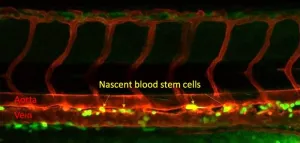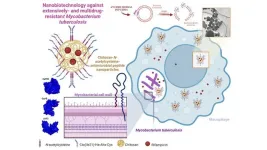(Press-News.org)
AMES, Iowa – A microbial sensor that helps identify and fight bacterial infections also plays a key role in the development of blood stem cells, valuable new insight in the effort to create patient-derived blood stem cells that could eliminate the need for bone marrow transplants.
The discovery by a research team led by Raquel Espin Palazon, an assistant professor of genetics, development and cell biology at Iowa State University, was published last month in Nature Communications. It builds on prior work by Espin Palazon showing that the inflammatory signals that prompt a body’s immune response have an entirely different role in the earliest stages of life, as vascular systems and blood are forming in embryos.
Espin Palazon said knowing that embryos activate the microbial sensor, a protein known as Nod1, to force vascular endothelial cells to become blood stem cells could help develop a method to make blood stem cells in a lab from a patient’s own blood.
“This would eliminate the challenging task of finding compatible bone marrow transplant donors and the complications that occur after receiving a transplant, improving the lives of many leukemia, lymphoma and anemia patients,” she said.
A critical cue
Stem cells are both the factories and the raw materials of a body, repeatedly dividing to self-renew and build new cells for specific tissues. Pluripotent stem cells in embryos can make any kind of cell a body needs, while adult stem cells are limited to producing particular types. Blood stem cells, also known as hematopoietic stem cells, make all of blood’s components. A lifetime supply of blood stem cells is created before birth inside an embryo.
The immune receptor Espin Palazon’s team identified activates in an embryo before endothelial cells start becoming stem cells, priming them for the transition.
“We know blood stem cells form from endothelial cells, but the factors that set up the cell to switch identity were enigmatic,” she said. “We didn’t know that this receptor was needed or that it was needed this early, before blood stem cells even form.”
Researchers zeroed in on Nod1 by analyzing public databases of human embryos and studied it using zebrafish, which share about 70% of their genome with humans. Blood stem cell creation tracked closely with Nod1 levels as its effects were inhibited or enhanced.
To confirm Nod1 also plays a role in human blood development, the research team worked with the Children’s Hospital of Philadelphia. Researchers there produce human induced pluripotent stem cells, which are generated from mature samples but genetically reprogrammed to behave like the make-anything stem cells found in embryos. Induced pluripotent stem cells can create most types of blood cells, though not functional blood stem cells. But when researchers took away Nod1, blood production faltered, as it did with blood stem cells in zebrafish.
Seeking self-derived stem cells
Figuring out that Nod1 is a prerequisite for blood stem cells to develop is progress for scientists hoping to design a system for producing blood stem cells from human samples, which could offer a revolutionary new option for patients suffering from blood disorders. Instead of a life-saving infusion of blood stem cells via a transplant of bone marrow, the spongy insides of bones that holds most of a body’s blood stem cells, patients could be treated with stem cells that originated in their own body. Self-derived stem cells could avoid the risks of graft-versus-host disease, a common and potentially deadly reaction that occurs when a patient’s immune system perceives the transplant as a threat to be attacked.
“This would be a huge advancement for regenerative medicine,” Espin Palazon said.
Espin Palazon’s team is continuing to untangle the complex interactions in which blood stem cells arise, including refining the timeline. Understanding when signals are expressed is essential to developing the methods for making blood stem cells.
“The timing is so crucial. It’s like when you’re cooking and you need to add ingredients in a specific order,” she said.
Further research will benefit from the collaboration with Children’s Hospital of Philadelphia, which trained one of the study’s co-authors – Clyde Campbell, adjunct assistant professor of genetics, development and cell biology – on the protocols to create induced pluripotent stem cells.
“My group at Iowa State University will continue working towards a life without blood disorders. I believe our investigations will pave the road to finally create therapeutic-grade blood stem cells to cure blood disorder patients,” Espin Palazon said.
In addition to Espin Palazon and Campbell, other Iowa State co-authors on the study include first author Xiaoyi Cheng, a graduate student; Karin Dorman, professor and Dale D. Grosvenor Chair of genetics, development and cell biology; graduate students Masuma Khatun Usha and Rodolfo Calderon; research associate Elizabeth Snella; and former undergraduate Abigail Gorden. Antonella Fidanza at the University of Edinburgh and Giulia Pavani, Deborah French and Paul Gadue at Children’s Hospital of Philadelphia also contributed to this work.
Funding for the research came in part from a $2 million grant from the National Institutes of Health and a $380,000 grant from the Roy J. Carver Charitable Trust.
END
The Medical University of South Carolina is one of nine leading research universities across six states partnering with Innosphere Ventures on its Regional Life Sciences Incubator. Innosphere Ventures is a Colorado-based life sciences incubator with proven methods for propelling startups to successful market entry. Funding from a $2 million three-year Build to Scale Venture Challenge grant from the U.S. Department of Commerce will create a regional incubator that will offer its partnering institutions and selected startups ...
Socioeconomic factors, like education and location, can affect access to life-saving prenatal care services. Researchers at Boston Children’s Hospital are taking steps towards implementing strategies that improve access to prenatal care: estimating how many pregnant people attend the recommended number of visits and identifying pregnant people who are at high risk of failing to attend. This could help policymakers allocate resources to populations not getting enough prenatal care and could, in turn, improve health outcomes for mothers and babies.
Led by Grace Chan, M.D., Ph.D., Attending Physician in the Intermediate Care Program at Boston ...
JMIR Publications is pleased to announce that JMIR Medical Education has passed the Scientific Quality Review for MEDLINE and has been accepted for inclusion in MEDLINE, which is the U.S. National Library of Medicine's premier bibliographic database.
JMIR Medical Education was already indexed in PubMed. MEDLINE is a more selective subset of PubMed, consisting of the top 5,200 biomedical journals, and indexing in MEDLINE also means that articles are now also indexed with NLM Medical Subject Headings (MeSH terms) and other metadata.
Selection for MEDLINE is a result of a thorough review ...
Fish from the same species can evolve their sense of smell and display individual foraging ‘personalities’ to successfully find food in different habitats, according to new research.
In the study, published today as a Reviewed Preprint in eLife, researchers developed a high-throughput behavioural assay to test spontaneous swimming and differences in the sense of smell of individual Mexican cavefish larvae. eLife editors described the work as important, presenting compelling evidence that the surface and cave morphs of the fish show different olfactory preferences and odour sensitivities, and that individual fish show substantial variability in their spontaneous ...
Scientists have identified the protein that helps poison dart frogs safely accumulate their namesake toxins, according to a study published today in eLife.
The findings solve a long-standing scientific mystery and may suggest potential therapeutic strategies for treating humans poisoned with similar molecules.
Alkaloid compounds, such as caffeine, make coffee, tea and chocolate delicious and pleasant to consume, but can be harmful in large amounts. In humans, the liver can safely metabolise modest ...
Toxic chemicals produced from oil emissions and wildfire smoke have been found in muscle and liver samples from Southern Resident killer whales and Bigg’s killer whales.
A study published today in Scientific Reports is the first to find polycyclic aromatic hydrocarbons (PAHs) in orcas off the coast of B.C., as well as in utero transfer of the chemicals from mother to fetus.
“Killer whales are iconic in the Pacific Northwest—important culturally, economically, ecologically and more. Because they are able to metabolically process PAHs, these are most likely recent exposures. Orcas are our canary in the coal ...
Schar School Researchers To Receive Funding For Nonprofit Employment Data Project
Alan Abramson, Professor, Government and Politics; Mirae Kim, Associate Professor, Nonprofit Studies; and Stefan Toepler, Professor, Nonprofit Studies, are set to receive funding for: "Nonprofit Employment Data Project."
The researchers will produce a comprehensive report on nonprofit employment in the United States, based on new data that is expected to be released by the U.S. Bureau of Labor Statistics (BLS) early in 2024. The researchers will also arrange for the transfer of the Nonprofit Works interactive database application, which is currently hosted by Johns ...
A low-cost technology involving nanoparticles loaded with antibiotics and other antimicrobial compounds that can be used in multiple attacks on infections by the bacterium responsible for most cases of tuberculosis has been developed by researchers at São Paulo State University (UNESP) in Brazil and is reported in an article published in the journal Carbohydrate Polymers. Results of in vitro tests suggest it could be the basis for a treatment strategy to combat multidrug bacterial resistance.
According ...
Marzougui & Kan Developing Crashworthy Tangent End Treatment For Low-Speed & Curbed Roadways
Dhafer Marzougui, Associate Professor, Physics and Astronomy, and Cing-Dao Kan, Professor/Director, Center for Collision Safety and Analysis, received $749,954 from the National Cooperative Highway Research Program for: "Development of a Crashworthy Tangent End Treatment for Low-Speed and Curbed Roadways."
This funding began in Nov. 2023 and will end in Nov. 2026.
###
About George Mason University
George Mason University is Virginia's largest public research university. ...
Wars, drought, displacement, and instability are causing a dramatic increase in the number of pregnant and breastfeeding women around the world who suffer from malnutrition. Without access to sufficient nutrients in the womb, babies born to these women are more likely to die due to complications like pre-term birth, low birth weight, and susceptibility to diseases like malaria. To try to reduce the risk of malarial infection, the WHO recommends that pregnant women in low-income countries be treated with a combination of the antimalarial drugs sulfadoxine and pyrimethamine ...




